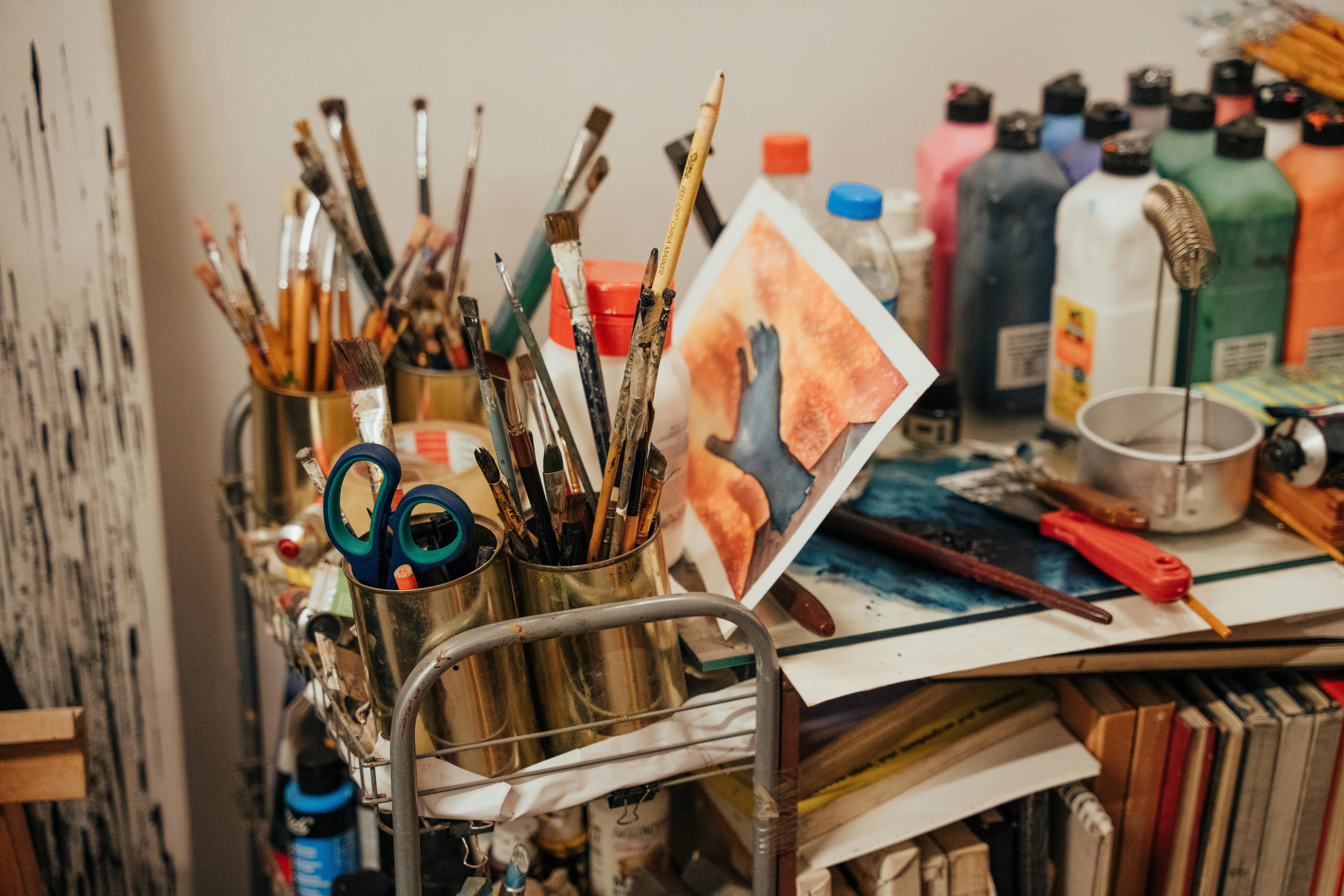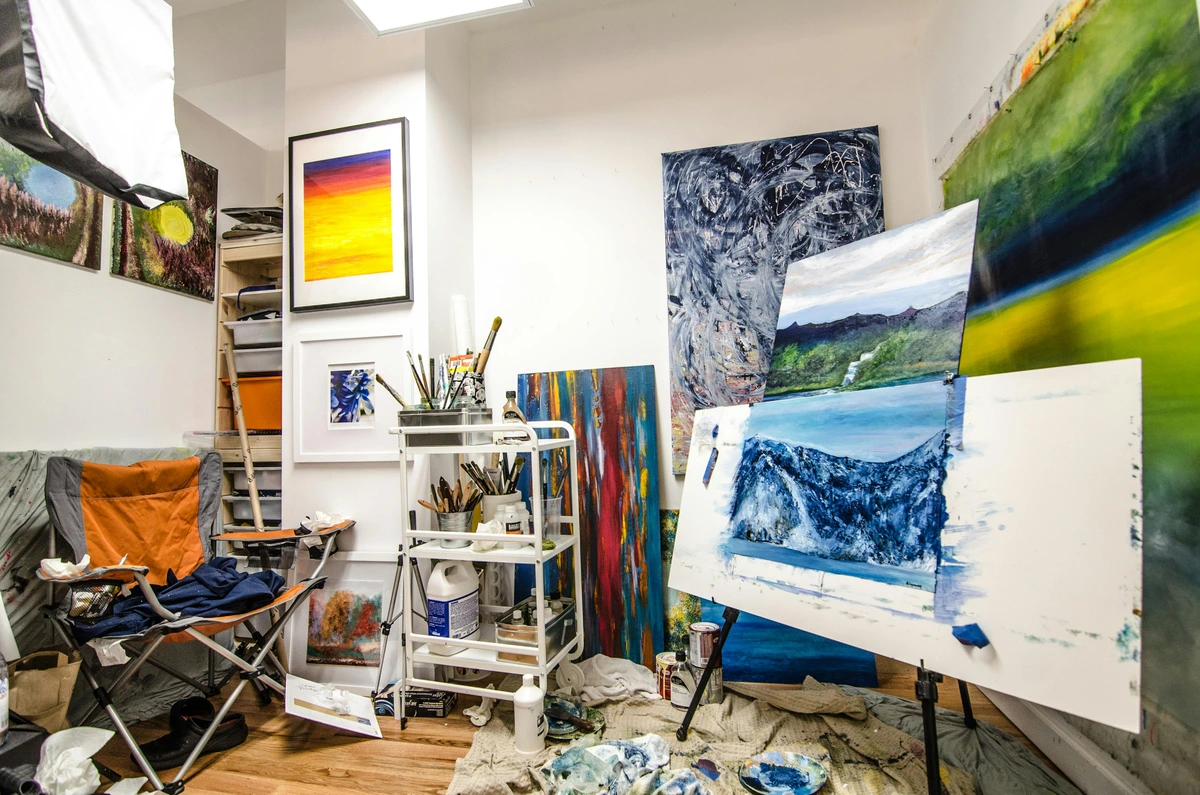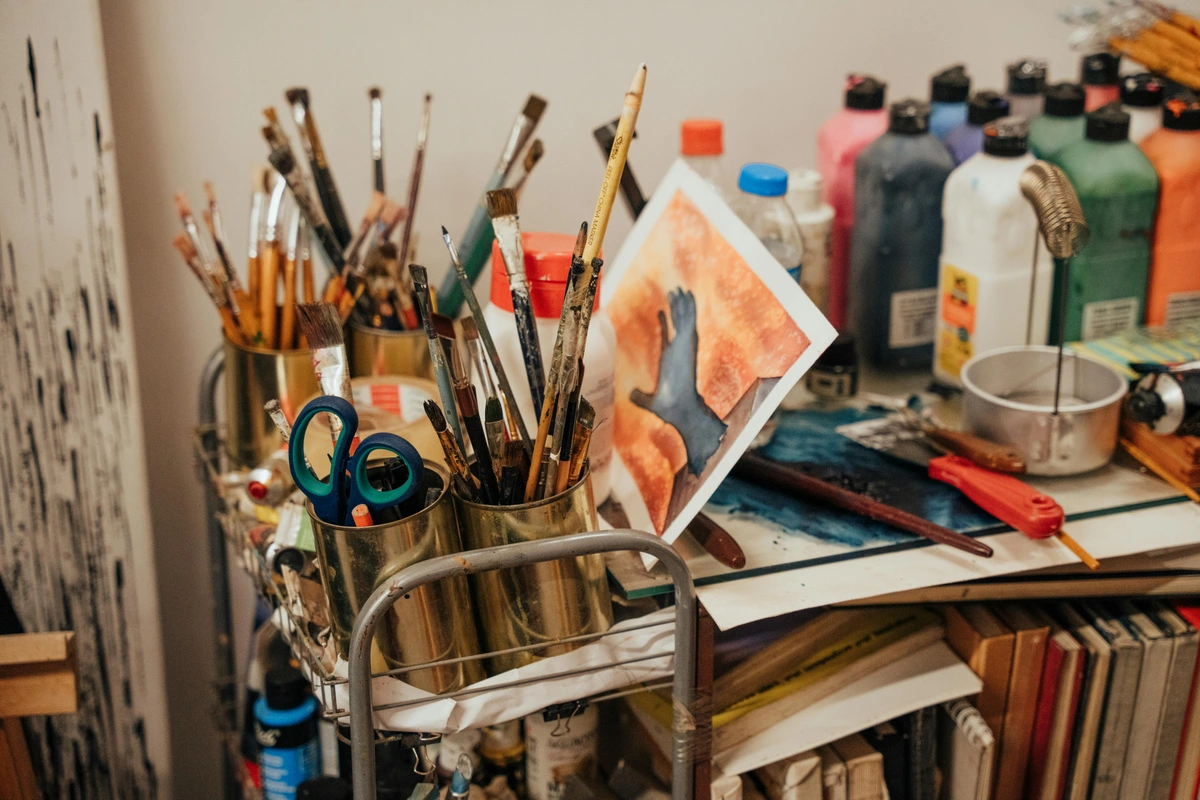
The Abstract Art Process: Intuition, Chaos & Creative Flow
Dive into an artist's personal journey of creating abstract art. Explore inspiration, the messy genesis, intuitive layering, and the challenge of knowing when to stop. Embrace chaos, trust the process, and discover your unique artistic flow.
My Creative Process: From Concept to Canvas in Abstract Art
This is a love story. But not the kind with grand gestures or moonlit serenades. It's a quieter, messier, infinitely more frustrating – like when a vibrant red you envisioned stubbornly refuses to harmonize with its blue neighbour – and ultimately profound kind of love: the one I have with the act of creating abstract art. For someone who cherishes solitude, diving into a relationship with something as unpredictable as a blank canvas can feel daunting. Yet, it’s a conversation, an evolving dialogue not just with pigment and form, but with the evolving self. It's rarely a grand plan, more often a whispered whim, a burst of feeling, or sometimes, just the sheer necessity of making a beautiful mess.
Join me on a candid journey through my process, where chaos often finds its hidden harmony. Along the way, we'll explore these stages: the elusive spark of an idea, the messy genesis of initial layers, the intuitive dance with the canvas, and the profound challenge of knowing when to stop.

The Whispers of an Idea (Or Lack Thereof)
Have you ever stared at a blank page, or a blank canvas, and felt... nothing? Sometimes it’s a flash, sometimes it’s silence. Where does inspiration truly come from? For me, it's rarely a lightning bolt striking a perfectly clear sky. More often, it's the quiet hum of the world around me, a half-forgotten memory, the weathered texture of an old wall, or even just the confronting blankness of an empty studio that sparks something. This initial courtship, where the canvas and I are just getting to know each other, can be painfully slow.
I've talked more about this elusive search for the muse in The artist's muse: where inspiration meets abstraction, but suffice it to say, it’s a fluid, sometimes maddening, process. And sometimes, when the whispers refuse to come, I've found that just showing up at the easel and moving paint around, even aimlessly, can break the dam. Sometimes I just start with a series of quick, gestural sketches or intuitive color swatches on a smaller canvas, not aiming for anything specific, just to get the hand moving and the mind out of its own way. Or I'll set a timer for five minutes and just promise myself to make any mark. Often, that tiny commitment is enough to unlock a flood. It’s an active surrender, a way to invite the muse when she's playing hard to get. For more on finding your creative spark, explore art inspirations.
I remember one particularly uninspired morning, I sat staring at a blank canvas for what felt like an eternity, feeling utterly useless. I even considered taking up knitting; it felt more productive. The air in the studio was thick with my frustration, a silence so loud it screamed. I eventually gave up, went to clean the kitchen, and then, amidst the suds and scrubbing, poof! An idea, a vibrant color palette, a vague, dynamic shape just... appeared. This "poof" moment, a passive reception of insight, often happens when my conscious mind is distracted, allowing the subconscious to process and synthesize abstract forms and connections without the pressure of direct focus. It's a quiet alchemy, much like trying to remember a forgotten word – the harder you try, the more it slips away. But then, there it is, usually when you're least expecting it, doing something entirely mundane. It’s a testament to the unpredictable nature of creativity; sometimes, stepping away is the only way forward.
And what about those truly "failed" pieces, the ones that never quite whisper? The emotional sting of a piece that just... doesn't work is real. It can feel like a personal rejection, a moment of creative inadequacy. But I've learned to see these not as failures, but as dormant possibilities. Often, I'll turn them to the wall, or even paint over them entirely. Sometimes, weeks or months later, a forgotten canvas from the "failure pile" will offer a new starting point, its previous mistakes now a rich, textured history. This ability to embrace failure as a foundation is crucial in this unpredictable relationship.
Once that whisper arrives, or even if it stubbornly refuses, the real, messy work of getting paint on canvas begins. This is where the initial infatuation meets the first, awkward dance.
The Messy Genesis: Translating Thought into Chaos
Once a whisper of an idea lands (or sometimes, even if it hasn't, and I just need to move something, anything), it's time to get messy. This phase isn't pretty, and frankly, it often involves a lot of second-guessing. It’s about experimentation, throwing paint with abandon, mixing colors until my palette looks like a forgotten culinary disaster that might still be vaguely edible if you squinted. Even amidst the chaos, I might subconsciously aim for a general sense of verticality or a dominant diagonal movement, a very loose, abstract compositional idea to anchor the wild energy. (Though sometimes, it feels more like I'm trying to herd cats with a wet noodle, which is about as productive.)
I might start with large, sweeping brushstrokes, pouring thin washes that bleed and mingle, or even aggressively scraping with a palette knife to lay down initial textures and raw, energetic shapes. The choice of materials here is crucial; the fluid nature of acrylics lends itself to rapid layering and quick drying, allowing for fast iterations, while oils, with their slower drying time, invite a more deliberate, considered buildup of luminous layers. My preferred tools? A few well-worn, large flat brushes for laying down initial washes, a couple of sturdy palette knives for texture, and surprisingly, old credit cards for sharp edges and scraping. I’ve learned that understanding the emotional language of color in abstract art is key here, even if I'm just splattering with wild abandon! To learn more about getting started, check out how to abstract art.

This is where I truly embrace the chaos. There's no preciousness here, no fear of 'ruining' anything. This raw exploration often unearths unexpected compositions or color relationships that a pre-planned approach would never reveal. It's in this uninhibited play that the painting truly finds its unique voice, free from the constraints of expectation. It's about getting the initial energy down, even if it looks like a toddler had a very enthusiastic paint party. And honestly, sometimes the 'ugly' phase is where the magic starts to peek through, like a grumpy caterpillar hinting at a magnificent butterfly. You just have to trust the process, even when it feels like everything is going wrong, even when you secretly wonder if you're just making mud. It's in this raw, unfiltered exploration that the true personality of the painting begins to emerge. This is the honeymoon period of chaos, a wild beginning to our story.
The Dance: Layers, Intuition, and Letting Go
This is the heart of it all, the true dialogue. With the first layers down, the painting starts talking back. It whispers (or sometimes yells) what it needs: more texture, a contrasting color, a brave wipe-out – literally, removing an entire section of wet paint – or an entirely new direction. This "conversation" with the canvas is deeply intuitive, much like dancing with a partner where you anticipate and respond to their subtle shifts. Perhaps it's a bold red demanding to be tempered by a muted blue, or a chaotic area that suddenly screams for a sharp, clean line to introduce a sense of role of negative space in abstract art. This back-and-forth is truly a dance, sometimes graceful, sometimes I accidentally step on its toes and we both stumble a bit.
This dance can span hours, or even days across multiple sessions, as layers build and dry, each return to the easel a new conversation, a fresh negotiation. There’s a beautiful patience required, an acceptance that some breakthroughs only come with time and space. To learn from this evolving dialogue, I sometimes document the process by taking photos at different stages or making quick notes on what the painting seems to be "asking" for. I remember one piece where I bravely (or foolishly) scraped off an entire section I’d loved, a vibrant swathe of magenta. My inner critic wailed, "You ruined it!" but the gaping absence it created revealed a vast, intriguing negative space that became the painting’s focal point. It was a terrifying moment of destruction that birthed something far more compelling. External critique? I rarely seek it during this phase. It’s too intimate, too raw. I trust my own gut, knowing that this dance is intensely personal.

It’s about trusting my gut, not overthinking every single brushstroke. There’s a certain freedom in knowing that in abstract art, there are often no 'mistakes,' only opportunities for new directions. The paint sings, the canvas resists or yields, and I respond. If you're interested in refining your own unique approach to art, my journey with developing your unique artistic style might offer some insights. This phase is less about intellectual planning and more about intuitive response. It’s about feeling the paint, feeling the canvas, and letting the work guide its own evolution. It's a relationship of push and pull, a constant negotiation until a sense of harmony begins to emerge. This intuitive push and pull is where the true soul of the painting is forged, leading inevitably to the next, often most challenging, decision. This is the passionate, sometimes tumultuous, phase of our love story.
The Great Pause: Knowing When to Stop
Ah, the eternal dilemma. When is it done? This is arguably the hardest part of the entire process, where the "love story" truly gets complicated. My studio is full of pieces I've proudly declared 'finished,' only to revisit them weeks later with a new color, a bold stroke, or, more often than not, a feeling of mild horror at my past self's confidence. It's a delicate balance, this dance between completion and destruction, like deciding when a relationship has found its perfect equilibrium, or when it needs a brave, albeit painful, ending.
How do you know when to stop? For me, there are a few subtle indicators:
- The painting feels quiet: Its elements are settled, no longer clamoring for attention.
- It stops asking for more: Its voice recedes into a satisfied hum.
- A profound sense of resolution emerges: A click into place where every element feels inevitable, like finding the missing piece of a puzzle.
- Deep exhaustion: A feeling that if I touch it one more time, I'll turn it into mud.
I've learned that pushing beyond that point, that overworking, often kills the very spark I've been nurturing. It's like trying to perfect a spontaneous laugh; you either get it, or you force it, and then it's just... awkward. I once added 'just one more brushstroke' to a piece I loved, a piece I was genuinely proud of, convinced it needed that tiny bit more definition. Within minutes, it looked like a muddy battlefield where all the beautiful nuances had been tragically lost. That painting now lives in the 'lessons learned' pile, face to the wall, a constant, silent reminder not to overstay my welcome.
To cultivate this skill, you might try:
- Setting a timer for your creative sessions and stepping away when it rings, regardless of where you are.
- Working on multiple pieces simultaneously, so you can rotate them and view them with fresh eyes.
- Having a trusted peer offer an objective opinion. Sometimes, that outside perspective is exactly what's needed to see if the conversation between you and the canvas has truly concluded.
So, I step back. I live with it. I might hang it on a wall, face it away, or even put it in a dark closet for a few days (the painting, not me, although sometimes I could use a dark closet and a strong cup of tea!). And then, I look again with fresh eyes. Does it still speak? Does it feel complete? Or am I just trying to fill another blank space, not on the canvas, but in myself? This is where I learn the profound lesson of knowing when to let go, when to say, with genuine acceptance, "You are enough." It's a declaration of love, not just for the art, but for the imperfect, evolving process itself. This decision marks a profound shift in the relationship, from active creation to appreciative acceptance.
The Quiet After the Storm: Letting Go and Naming
Once a piece is declared 'finished' – usually with a sigh of relief mixed with a touch of melancholy – the conversation shifts. It's no longer a dialogue of intense creation, but one of reflection. It hums with its own energy now, a silent symphony of color and form. This is where the post-creative processing begins, a period of quiet contemplation.
I sit with it, sometimes for days, allowing it to tell me its name, what it wants to be called. It's a surprisingly intimate process, like naming a child or a beloved pet (though with less actual barking). For abstract art, a title isn't just a label; it's often the first whispered clue the artwork offers to its viewer, a poetic invitation rather than a literal description. Sometimes the title emerges from a feeling, a memory, or even a random word I heard while painting. "Echoes of Dawn" might come from a soft blending of yellows and grays, while "Urban Pulse" could be a frantic, jagged composition. This naming process is the final, intimate act of understanding the piece's soul.
This includes high-quality photography from various angles, careful documentation of dimensions and materials used, and sometimes even notes on the initial inspiration or challenges encountered. These practical steps ensure the piece is ready not just for display, but for its own journey out into the world. Then comes the formal goodbye: varnishing to protect its new skin, framing if needed, and preparing it to face the world. This is where the personal journey becomes public.

And this is also where the piece truly comes alive in a new way: through the viewer's interpretation. Abstract art thrives on personal connection, and the moment it leaves my studio, it begins to tell its own stories, often revealing new facets I hadn't intended. This completion of the piece by another's gaze links back to the idea of the art having "its own life." Understanding what makes abstract art compelling is part of this final stage, seeing how it connects with others, entirely independent of my initial intent.
And yes, sometimes it goes off to find a new home, perhaps through my art for sale collection or gracing the walls of my Den Bosch museum studio. It's a strange blend of pride and a quiet ache, like sending a grown child off into the world, but sometimes, it's also a profound sense of relief, a feeling of having truly completed a cycle. A quiet 'thank goodness that's done, and it didn't end up in the 'lessons learned' pile!' You’ve given it everything, and now it has its own life to live, its own stories to whisper to others. This phase, then, is about letting go, allowing the love to become universal.
The Unending Conversation
So, what began as a 'love story' — or at least, my attempt at one — truly is an unending conversation. It's a messy, glorious, frustrating, and deeply personal dialogue with colors, textures, and the evolving self. It's about finding beauty in the chaos, trusting the whispers of intuition, and having the courage to declare 'enough.' Abstract art, for me, isn't just about what ends up on the canvas; it's about the journey of becoming, the continuous process of discovery, and the profound connection forged in those quiet, messy, and wonderfully unpredictable moments in the studio. This continuous process of discovery, this dance between chaos and resolution, is at the heart of abstract creation for many artists, a universally recognized truth in the often-solitary pursuit of art. And perhaps, that's a kind of love story worth telling after all, a testament to the enduring bond between creator and creation. For those curious about the broader journey, my timeline offers a glimpse into how this conversation has evolved over the years. This ongoing exploration defines what is the meaning of art for me, making every stroke a step further into understanding myself.
The canvas always calls again, doesn't it? The next piece, the next dialogue, is always just around the corner, waiting for its own messy genesis and quiet resolution. What does your creative process whisper to you? I'd love to hear about your own artistic journey – what unexpected moments or challenges have shaped your unique process?




